Oxford University Press's Blog, page 139
July 23, 2020
Charles Darwin’s five-year journey [timeline]
Charles Darwin is most known for his journey to the Galapagos Islands, and for the work he published around the theory of evolution, The Origin of Species, as a result of that trip. And though his time in the Galapagos was vital to Darwin’s work, he also visited many other places, a small selection of which are featured here. While the ship itself was commissioned to survey the coast of South America, Darwin was on board to make the scientific observations for which that he is remembered.
Image by Alin Meceanu via Unsplash
The post Charles Darwin’s five-year journey [timeline] appeared first on OUPblog.

July 22, 2020
Dry and thirsty, part 2: “dry”
The beginning of this story appeared a week ago, on July 15, 2020 (Cut and dried, Part 2), and we found out that the Old Germanic languages had two words for “dry”: thur-s– (from which Modern English has the noun thirst; thor–s is the Gothic form) and dreag-, the parent of dry. Seeing how concrete and unambiguous the idea of dryness is, we wondered why Germanic needed two synonyms for this word. We have also seen that thur-s– had at least one cognate outside Germanic, namely, Latin torridus “torrid,” but the origin of the root tor– remains unclear. It would be important to know what association suggested to people the idea of dryness. The idea must have come from some object which was indeed very dry or from a sensation we, with our penchant for scientific terms, now call dehydration. (Wet, for example, is related to water.) Torrid looks rather isolated. Its best, though uncertain, connection is with Latin terra “earth,” another isolated word in Indo-European. Yet the idea that thur-s– was suggested by parched earth is feasible. Unlike thurs-, dreag– has no cognates outside West Germanic. It was probably coined locally, and that is why its etymology remains undiscovered.
 Dry logs, hardly the source of the word “dry.” Image: public domain via pxfuel.
Dry logs, hardly the source of the word “dry.” Image: public domain via pxfuel.As mentioned last time, we might perhaps dispel part of the mystery if we found out what motivated the speakers of other languages to coin their words for “dry” and whether English can provide some help. Two English adjectives suggest themselves as candidates for a brief examination. The first is the verb to sear “to burn or scorch with intense heat.” It goes back to the oldest period and is related to the obsolete adjective sere “dry, withered.” Today, both are pronounced alike, but in the past, they were not homophones.
Sear has cognates throughout Indo-European, including Latin sūdus “dry; cloudless.” As though to mock us, the closest neighbor of sūdus was sūdare “to sweat; ooze, exude (ek-sude).” Is this unnatural proximity the reason Latin sūdus was replaced by siccus? Even if not so, we note that a language may have two words for “dry,” both native, with the newcomer ousting the old one, as also happened when dreag– replaced thur-s-. Siccus continued into the modern Romance languages and is known to wine drinkers from French sec and demi-sec.
The other reason siccus deserves mention in this story is the presence of cc in the Latin word. If we throw a quick look at the vocabulary of old languages, we will see that double consonants (geminates) are the product of either some late phonetic process (most often, assimilation, as in the Scandinavian languages) or emphasis. Emphatic geminates are usually called expressive, and in siccus, cc (that is, kk), which does not owe its existence to assimilation, must be expressive. What was the motivation for that emphasis? We can only indulge in second guessing, but, as noted in the previous post, dry is not a neutral word designating some trivial quality. It refers to thirst or drought, two mortally dangerous things. The coining of the word must have entailed a good deal of negative emotion. Incidentally, Classical Greek iskhnós “dry” also has the middle consonant from an expressive geminate.
The other Classical Greek adjective for “dry” was kserós, recognizable from the English words beginning with xero– and the ubiquitous Xerox. But in Greek, it occurred rarely, only as an epithet applied to earth. The word may be related to Latin serēnus “cloudless.” Though the phonetic correspondence is plausible, the meanings do not match too well. The Greek adjective may be related to a word in Sanskrit and a word in Old high German. Yet from an etymological point of view the entire group is rather obscure.
The last station on our journey is Engl. arid, from French aride or directly from Latin āridus. For a change, here the origin is clear. Among the words in many languages related to arid, we find Gothic azgo “ash, cinders.” Gothic, it will be remembered, is an Old Germanic language, recorded in the fourth century. The ancient root seems to have meant “to burn.” Here is another approach to the coining of an adjective meaning “dry.” Other (doubtful) connections can be ignored.
What then have we learned? Indeed, not much, but the adventure has not been useless. First, it has become clear that a word for “dry” is often obscure and that in this respect Germanic dry is not an exception. Second, we now know that the existence of two native synonyms for “dry” is not uncommon. A later neologism may supersede the old-timer, as also happened when dreag– replaced thur-s-. Third, the word for “dry” need not have been stylistically colorless (hence the geminates)—an important point. Fourth, regardless of whether torrid and terra are related, an adjective for “dry” has been attested that is mainly applied to describe earth. Finally, a possible motivation for coining an adjective for “dry” is the reference to burning (hence ashes) and perhaps brightness (if Latin serēnus belongs to our story).
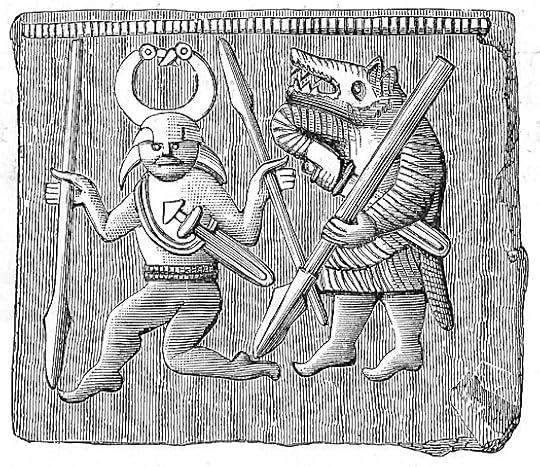 An Old Scandinavian warrior: tough and firm, but not dry. Engraving of a bronze plate featuring a berserker on the right and Oden on the left. Public domain via Wikimedia Commons.
An Old Scandinavian warrior: tough and firm, but not dry. Engraving of a bronze plate featuring a berserker on the right and Oden on the left. Public domain via Wikimedia Commons.Where then does Engl. dry belong? As noted above, the answer has not been found. Yet we should remember that it is not only some ancient root that we are looking for. We want to understand why thur-s– acquired a powerful rival. With regard to the root, two Old Icelandic words have been cited in connection with dry. One is drjúgr “tough, able to endure hardships.” The other is draugr “revenant, malicious ghost” and its unrelated homonym “man; warrior.” Obviously, the revenant need not bother us here, but draugr2 also meant “tree” and is often glossed as “dry tree, dry log.” Even if the sense “dry log” is valid, that is, if dry and draugr are related, this fact does not tell us anything about the root’s origin: “tree” must have received its name because it was dry, not “dry” from the dryness of the tree.
To make matters worse, it is far from clear that draugr meant “dry log.” Besides, draugr “man, warrior” is certainly related to a verb for “endure; serve in the army” (English has its remnant in the curious archaic phrase to dree one’s weird “to endure one’s fate.”) This second sense has exact parallels in Slavic and may even be initial. Conjuring up drjúgr suggests that the development of the sense “dry” came from “solid, firm,” a possible, but distant path (one expects reference to a dry object, rather than another quality). Finally, it causes surprise that the only word, allegedly able to throw light on a West Germanic adjective, has been recorded only in Scandinavian. I will skip some other, even less convincing, hypotheses and the suggestion that dreag– came to Germanic from an unknown substrate language, and will also pass over the discussion of the phonetic form of the Old English adjective.
My own arrow shot into the air, as I called my conjecture last week, is that dreag– was coined to express the difference between human thirst and the thirst of the soil (drought). Thur-s- supplied the material, but reference to drought filled people with such fear that they invented a taboo word, by “perverting” the sounds: they retained th (it later became d), added –g, and changed u to au; r was already there. This reconstruction cannot be proved (an example of one man’s dry humor). Yet it is perhaps more credible than reference to borrowing from a substrate and more inspiring than the verdict: “Origin unknown.”
 The true inspiration for coining a word for “dry.” Left image: Ion Chibzii. CC BY-SA via Wikimedia Commons. Right image: _Marion. Public domain via Pixabay.
The true inspiration for coining a word for “dry.” Left image: Ion Chibzii. CC BY-SA via Wikimedia Commons. Right image: _Marion. Public domain via Pixabay.Feature image credit: image by Paul Barlow. Public domain via Pixabay.
The post Dry and thirsty, part 2: “dry” appeared first on OUPblog.

July 21, 2020
How much do you know about media law? [quiz]
If you are working in the journalism industry, studying for an exam, or just interested in media law and journalism, we have had a bit of fun putting together a light-hearted quiz on media law in the United Kingdom. Take the quiz to test your knowledge or learn something new.
Featured Image Credit: Women look at security cameras, by Matthew Henry via Unsplash.
The post How much do you know about media law? [quiz] appeared first on OUPblog.

July 20, 2020
How we decide on cultural canons
Libraries, museums, and galleries are a few of the places where humanity attempts to preserve and transmit its cultural memory. The contents change depending on the period, even the time of the year, the community, and the target audience, but the aim remains the same: to preserve and renew memory and by extension to transfer and circulate knowledge. The same applies to canons: literary canons, religious canons, music canons, film canons, art canons. The best, the most known, the most prominent, the most famous, those who made it through time would form the select group that would make it in the list, the canon, any canon. In all of these cases what is selected in each category represents and embodies a fragment of the whole, and in turn the whole embraces and encapsulates all individual parts, be that items, names, or titles. Recognizing this interdependence is what allows the selection to function as a canon and for each individual part to be identified as canonical.
Selective processes that have as a result the creation of canons were a feature of antiquity as much as they are a feature of the present time. The same questions can be asked for both then and now: Who chooses what will be included in the canon? When is this selection made? What is valued in order to make something canonical? Does the canon change, and if so, how often, under what circumstances, and by whom? Greek literature knew of many literary canons, especially for literary genres that were represented by more than one author or for literary creations that were spread in time through the centuries: comic, tragic, iambic, lyric, historiographic, and oratorical canons, all collections of names of individuals who represent a certain time-period, a certain kind of writing, a certain corpus. Each of the names prompts genres, poems, speeches, writing styles, even biographical stories and anecdotes.
The most stable of the literary canons of ancient Greece was the Lyric Canon that comprised nine lyric poets, who, according to the first source that transmits this selection, ‘constituted the beginning and end of lyric poetry’ (AP.9.184). The emergence of the Lyric Canon did not come out of the blue; to its creation and establishment contributed authors, philosophers, and scholars from the fifth to the third century BC, and of course the well-established fame of the poets themselves. The nine lyric poets—Alcaeus, Alcman, Anacreon, Bacchylides, Ibycus, Pindar, Sappho, Simonides, and Stesichorus—were active in the Greek world from the end of seventh to mid-fifth centuries BC, and although in none of the sources where their poems are recalled these poets are called canonical, the ease with which their personae and poetry are evoked testify to their wide-spread fame and recognisability. The reception of the nine in the classical and post-classical eras and the transmission of their poetry follow a pattern that remains unchanged from the fifth to the third century BC and which is inherited by the Hellenistic scholars in the Alexandrian Library. Their names as the selected nine are, subsequently, set in stone in the epigrams that preserve the Lyric Canon (AP.9.184 and 9.571).
Canons retain the past as actively circulated memory, which is intended for continuous use and re-use in both the present and the future. Canonical selections preserve memory, but neither as forgotten archives nor as dusty storehouses; they communicate in new presentations and frameworks what is meant to be remembered. As they connect the present with the past within the broader context of the collective, the uninterrupted circulation and (re-)affirmation of the value of canons contributes to the making and to the preservation of cultural memory. Similarly, the constant activation of cultural memory enables communities to gain historical consciousness, to develop their self-image, to realise a sense of belonging, and to form their identity, both social and cultural. In other words, cultural memory creates, enacts, and re-enacts cultural inheritance.
Within this cycle, therefore, canons are turned into carriers of memory. Aleida Assmann states emphatically that cultural memory is transmitted and embodied through performances and practices, and this performative feature connects any theory on cultural memory with Greek lyric. What is for modern readers a poem on a page was for the Greeks a performed song, sung and often danced to music. Think of music and dance performances nowadays. Every melody in a classical concert, every pas de deux in a classical ballet carries a history that is shaped by earlier performances; different dancers, choreographers, directors, musicians, different stage, but the same piece. Every performance re-embodies cultural memory, and re-enacts its past. Similarly, the names of the nine in the Lyric Canon embodied in antiquity their own poems and performances, and sustained throughout the centuries this cultural memory that passed as cultural inheritance from generation to generation. This chain remains uninterrupted even down to the present day.
Photo by Steven Shaffer on Unsplash
The post How we decide on cultural canons appeared first on OUPblog.

July 19, 2020
What the United States can learn from Portuguese politics
Donald Trump’s Independence Day attack on the culture of inclusion and equality highlights a problem long with us. Far from being united by principles enshrined in the country’s origins, America has long suffered deep discord over what lessons to draw from the nation’s history and how to tell the story of our past. Conflict over the treatment of minorities – and the bounds of inclusion in the country’s imagined community – has punctuated American history since independence. Even after the end of the Trump presidency, the pursuit of equality and inclusion – and restoring some sense of national community – will require finding better ways to build on what we do with the country’s political past and the way we talk about it.
A good place to start is by taking seriously the best examples of how other countries have managed to build in useful ways on their past. As the COVID-19 pandemic tragically reminds us, at times the United States has handled shared challenges less successfully than other countries.
Useful, even inspiring, lessons are to be found in a small country at the western end of Europe, Portugal. Like the United States and France, Portugal looks to a revolution that enunciated principles of equality as the origin of its democracy. But more than those larger and more powerful countries, Portugal has dedicated great cultural and political efforts to constructing a shared political culture rooted in its founding moment – the Carnation Revolution of 25 April 1974 – when an uprising led by army captains brought an end to decades of dictatorship. It was the Portuguese who inaugurated democracy’s worldwide third wave of expansion beginning on that day.
After the ravages of the 2008 Great Recession, Portugal became the only country in hard-hit southern Europe where satisfaction in democracy, and trust in political institutions, ranked above the average for Europe as a whole. The Portuguese actually diminished inequality somewhat during that crisis. They have the lowest unemployment and poverty of southern Europe and have largely escaped the growth of far-right populism that bedevils much of the world. These triumphs are directly related to the country’s ability to draw culturally on the revolutionary origins of its democracy and to foster a deeply inclusionary understanding of politics.
Every year the Portuguese celebrate their 1974 Carnation Revolution in many ways – inside parliament and in the streets, schools and many other locations. Crucially, an annual session of parliament devoted to remembering the 1974 events is broadcast live on television and is followed by a large public demonstration. Numerous other commemorative acts, many focused on telling the story of the revolution to children, bolster the creative breadth of the annual event.
In the annual session of parliament, televised live every 25 April, political leaders exchange views on the lasting significance of the country’s liberation by revolution in 1974 and on the current meaning of those origins. Predictably, the parties differ somewhat in the points they emphasize, but perhaps due to the interactive and public character of their reflections, core principles have come to shape their speeches.
This annual interactive event has helped build wide cultural consensus that eluded the Portuguese before 1974. The revolution’s promotion of inclusionary participation, welcoming all voices into the public arena, is celebrated not only on the left but also by those to the right of Portugal’s center. The poetry of the revolution, a term often used by the Portuguese, is repeatedly noted by speakers of left and right who tell the story of their revolution and its enduring meaning. Over time the degree of consensus has grown. Songs and symbols once linked to the left are now applauded also by many on the right. The annual public exchange has helped to produce a political culture that welcomes the voices of the dissatisfied into the democratic arena, treating them as important.
Portugal’s political culture of inclusion shows its marks in many arenas. In the news media – where journalists share in setting policy of media organizations – coverage incorporates voices of the poor and other outsiders. In the school system, students and teachers have helped to shape policies friendly to diversity and creativity. Crucially, the country has incorporated large numbers of immigrants from former colonies in Africa and Asia. Prime Minister António Costa is the son of an Indian-origin immigrant, but his skin color is an undiscussed non-issue. Political life is built on the assumption of inclusion.
During the economic crisis that began in 2008, parties remained at least somewhat attentive to demonstrators and other dissatisfied citizens. In September 2012, the most aggressive austerity measure of that period was rolled back by a right-wing government after a nationwide campaign of protest. Government authorities cited their commitment to listening to voices of popular opposition. Earlier, in responding to the beginnings of economic crisis, a Socialist government combined egalitarian ideals and pragmatic moderation. Although external pressures pushed governments to impose cutbacks, they managed to reduce inequality somewhat – a record remarkably different from that of neighboring Spain in the same years.
Portugal emerged from the Great Recession with a political system that remains more socially responsive and less polarized than in many other countries. Existing political parties limited the populist far-right to just one parliamentary deputy in elections last fall. Their approach to politics, celebrating political inclusion, participation and their democracy’s revolutionary origins has greatly helped the country weather difficult times. Policy-making triumphs including successes of the educational system and the region’s lowest unemployment rate have attracted international attention. The interactive cultural work annually telling the story of their democracy’s origins and celebrating political inclusion has bolstered these successes. In contrast, the United States – and France – have not attempted such a robust annual program of public exchange on the revolutionary origins of their political systems.
Efforts to draw meaning and inspiration from the past cannot eliminate economic conflict or political challenges, but creative public exchanges such as Portugal’s annual commemorations can help to build and sustain a better political playing field than the one that currently bedevils the United States. Portugal’s lively annual celebration of democracy’s revolutionary beginnings offers potentially useful example to a deeply troubled America nearly two and a half centuries after the 1776 proclamation that all men are created equal.
Featured Image Credit: fdecomite via Flickr
The post What the United States can learn from Portuguese politics appeared first on OUPblog.

Three philosophical problems for curious people [reading list]
It is part of human nature to be curious and to want to know or learn something. There are papers that fulfil this yen for knowledge and explore some of the more unusual philosophical questions that you never knew you wanted to know the answer to, for example; What did the tortoise say to Achilles about logic, propositions, and conclusions? Why the peculiar spelling of the logical term intension? Which came first – the chicken or the egg? Below are some excerpts from the accessible classic papers that explore these important and quirky questions for you to ponder.
“What the Tortoise Said to Achilles” by Lewis Carroll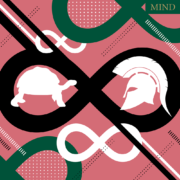
Achilles had overtaken the Tortoise, and had seated himself comfortably on its back.”So you’ve got to the end of our race-course?” said the Tortoise. “Even though it does consist of an infinite series of distances? I thought some wiseacre or other had proved that the thing couldn’t be done?””It can be done,” said Achilles. “It has been done! Solvilur ambulando. You see the distances were constantly diminishing; and so—””But if they had been constantly increasing?” the Tortoise interrupted. “How then?”
“Then I shouldn’t be here,” Achilles modestly replied; “and you would have got several times round the world, by this time!”
“You flatter me—flatten, I mean,” said the Tortoise ; “for you are a heavy weight, and no mistake! Well now, would you like to hear of a race-course, that most people fancy they can get to the end of in two or three steps, while it really consists of an infinite number of distances, each one longer than the previous one?” Read the rest of the article here.
2. “Why the “S” in “intension”?“ by Mary Spencer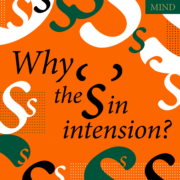
The peculiar spelling of the logical term “intension” has always given pause to laymen readers of English logical prose. From time to time, in fact, even the initiate tend to become confused. Peter Geach, for instance, in his admirable book Reference and Generality, insists on the spelling “intentional”:
This is the etymologically correct spelling: the adjective in this use refers to the intention of a term, i.e. what we intend by it. The spelling ‘intension(al)’ came in from a characteristic muddle of Sir William Hamilton, who thought the intention of a term was a sort of intensive magnitude, the Scholastio intensio; the spelling of ‘extension’ has no doubt been influential too. Hamilton’s misspelling has ousted ‘intention’ from its application to terms, except when preceded by ‘first’ or ‘second’: the spelling of the adjective or adverb ‘intentional(ly)’ and of ‘intentionality’ in current philosophical literature is merely chaotic. Read the rest of the article here.
3. “The Chicken and the Egg” by Robert Teichmann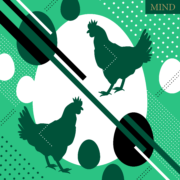
Human experimentation aside, every chicken is hatched from an egg. And every egg from which a chicken might be hatched is laid by a chicken. Equally and correspondingly commonplace is the fact that every chicken is born of chicken.
Unless one believes in miracles, one may well deem such generalizations as the above to be unsusceptible of particular qualification, as: “… except for Smith’s prize bantam”, even if they are susceptible of general qualification, as: “… except for chickens born in vitro“. If this is so, then we cannot qualify “Every chicken is born of chicken” by “… except for the first ever chicken.”
But now a problem arises, the problem raised by the old chestnut: “Which came first—the chicken or the egg?” Read the rest of the article here.
Featured Image Credit: ‘Books on bookshelf’ by Alfons Morales via Unsplash. [image error][image error]
The post Three philosophical problems for curious people [reading list] appeared first on OUPblog.

July 18, 2020
How face masks can help us understand the world
When historians only focus on written sources, they risk missing vital aspects of the historical record. The material traces of the past, the things people have chosen made or used, can offer important evidence allowing us to understand the historical value of the material world.
We can understand the relationship between material culture and history through five main lenses. First, cognition: How do people think with and through things? Next, technology, or how do things help us achieve everyday goals? Next, the symbolic: What can things come to mean or signify, or, how do things relate to belief or the immaterial? The category of social distinction allows us to think through how things sort people into groups or create boundaries and hierarchies. Finally, memory challenges us to ask how material things shape our understandings of the past.
These five approaches offer a new framework for thinking about how material culture intertwines with the study of history and provides a roadmap for future scholars to explain the value of material sources.
The COVID-19 crisis is altering our relationship to material things, and the stuff of this crisis will be important sources for historians. The stark choices we are all confronting as we practice social distancing—or we or our loved ones face quarantine, hospitalization, or job loss—highlight what objects may afford or allow for. Some items, like cloth masks, might feel vital to our personal and community safety and our ability to move in the world, while other objects may seem to hold hidden risks, traces of unknown people who have engaged with them before. Concerns over the level of PPE and ventilators are simultaneously understood as supplies in a chain of financial decisions and as vital life-saving tools for medical staff and patients.
Objects come to stand in for new ways of interacting with each other as we all do our part “to flatten the curve” or, barring that nationally, keep our own communities as safe as possible from the spread the of COVID-19. Masks, gloves, toilet paper, our children’s kindergarten worksheets, at-home summer camp activities, or the sourdough bread you may be baking or the seeds you have planted with the new time you have, take on metaphorical meanings and become physical receptacles for personal and national stories.
Our long-term relationship to things will likely change in some ways due to this pandemic. Perhaps we are paying attention to material things in new ways, too. The material traces of these transformations will be vital sources for future historians who want to understand how our universities and institutions maintained the important work we do of supporting and educating our students and building and sharing cultural resources through this crisis.
I can’t help but think about the red-checked cloth mask I started wearing in the early days of the pandemic through that lens. The five material culture approaches can shape the way I understand this small piece of cloth:
Cognition—Can this item really help me determine where my germs end and another’s begin?Technology—What makes a safer mask and how do we know? Who decides?Symbolic—How does this item represent something I can do to help or something I can control? Does it have public health and well as political meanings? What values and messages does it convey?Social Distinction—How are others in my community approaching this? Why are we responding differently? How can I help? What aspects of social identity can a mask present?Memory—What will this mask mean to us someday when this is over, perhaps sitting in an acid-free museum storage box? Whose story will it tell? Is it a story about public health and its success or failures, supply chains, or protest?The material choices we make today matter to our individual lives and also reflect broader and meaningful cultural patterns. These micro and macro patterns leave material traces behind them that thoughtful historians should consider.
Featured Image Credit: “Surgical face mask” by NurseTogether. CC BY-SA 4.0 via Wikimedia Commons .
The post How face masks can help us understand the world appeared first on OUPblog.

July 17, 2020
A philosopher’s perspective on the cruelty of Donald Trump’s immigration policies
The Trump administration announced earlier in the month that it was changing the rules for foreign students in the United States. Given that COVID-19 forced most universities to shift to online teaching, foreign students had been allowed to stay in the United States and continue their educations online. The Trump administration tried to take this option away; foreign students doing coursework online would be subject to removal –deportation, followed by a ten-year statutory ban on admission to the United States.
Facing opposition from hundreds of universities, the administration subsequently abandoned these changes, while leaving legal space to try again later. What is striking, however, is how much of the public comment on these changes began with a single moral notion: cruelty. Elizabeth Warren, President of Harvard Lawrence Bacow, and American Association for the Advancement of Science President Sudip Parikh described these new legal norms as cruel in public statements. This is fascinating – in part because, for much of the past fifty years, the notion of justice has dominated moral discourse about public affairs. In the philosophical academy, the roughly fifty years since John Rawls’s A Theory of Justice have led to sophisticated theorizing about the nature of justice – understood here as a concept relying upon political equality and the avoidance of social unfairness. What, though, compels us to reintroduce the notion of cruelty, to adequately critique Trump’s approach to migration?
Something can be cruel, in the first instance, without being unjust; we can be cruel towards those to whom we have no particular duties of political equality. Indeed, Michel de Montaigne, the 16th century humanist – and Judith Shklar, his 20th century intellectual descendant – both took cruelty to be a natural human failing, which has a particular home in those spaces in which people are not predisposed to think of each other as moral and political equals. We are, said Montaigne, often tempted towards cruelty towards those who are vulnerable to us; it is the fact of their vulnerability, in part, which makes us want to hurt them. The desire to hurt, moreover, is at the heart of what cruelty is. All policy – no matter how well-designed – will cause pain to some people; the goal for public policy is to figure out how to design that policy, so that the pain is minimized (and distributed fairly). Cruel policies, though, take the hurt of some people to be, not a necessary evil, but a positive good; cruelty, as Montaigne has it, involves taking the pain of one’s enemies to be a sort of spectacle, watched for enjoyment, rather than regretted and subjected to public justification.
On this analysis, the concept of cruelty seems quite appropriate for the changes recommended by the Trump administration. Adam Serwer, in an earlier comment on Trump’s approach to migration, made the point succinctly: The cruelty is the point. The ability to mark out some people as subject to disproportionate pain is a sort of ceremonial invocation of differential status. They are outsiders, and can be hurt without good reason, and that fact in itself marks the insiders as special. The foreign students hurt by the proposed policy are perfect tools for this sort of ritualized cruelty. These students are, after all, foreign nationals attending institutions of higher education. President Trump’s populist base has made no secret of its disdain for both students and people from other countries. The pain experienced by such students would be significant; they would have found their courses of study disrupted, their careers put on hold, and the hard work of academic discovery – running experiments, writing papers, doing field research – made impossible. The benefits to the United States from these policy changes would have been negligible – indeed, the policy would have been likely to harm the United States economy – but that is largely irrelevant; the policy changes would not need to help anyone – they were intended simply to hurt, and if Montaigne’s analysis is correct, then that fact marks them out as cruelties. There may have been other government purposes at play – such as convincing foreign students to go elsewhere in the future – but it is hard to find any explanation for the proposed changes more convincing than the sheer desire to punish those foreign students who have decided to study in the United States.
The proposed changes have been rescinded, for the moment; but those of us who work in higher education spent a week fielding panicked emails from foreign students – whose reaction to these proposals ranged from mystification to terror. There are any number of reasonable views about what purposes ought to be served by migration policy. We might hope, however, that the mere imposition of pain upon the vulnerable should not be among those purposes. When such policies as these are reintroduced – and they will be – we can only hope that understanding them as cruel can begin the process by which their cruelty is overcome.
Featured Image Credit: by Ross Sneddon on Unsplash
The post A philosopher’s perspective on the cruelty of Donald Trump’s immigration policies appeared first on OUPblog.

How John Harrison invented the first portable precision timekeeper
It’s been over 50 years now since Colonel Humphrey Quill wrote his biography (1966) of the great pioneer of the marine chronometer, John Harrison (1693–1776). Since then, there has been a increasing interest in Harrison and the events surrounding his inventions and discoveries. Indeed, over the years, this interest has caused something of a stir in academic history-of-science circles. This seems to have been because the discussion of Harrison’s achievements has mostly been published and brought to the attention of the public by non-academics.
Harrison was famously the inventor and creator of the first portable precision timekeeper, the marine chronometer.1993 saw the 300th anniversary of Harrison’s birth and many excellent celebrations, including a conference on longitude at Harvard University. This event inspired Dava Sobel’s accessible best-seller Longitude and it was this book which saw the beginning of real criticism from the academic world. Two of the main objections to Sobel’s book were her portrayal of Harrison as a lone genius, without support when he needed it most, and her portrayal of his nemesis, the astronomer royal, Nevil Maskelyne, as a villainous manipulator. Neither of these characterisations, critics said, was remotely true, and called for a better-balanced narrative of the facts.
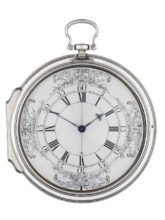 H4 – Harrison’s prize-winning longitude watch and progenitor of the modern chronometer, completed in 1759. Used with permission by the National Maritime Museum.
H4 – Harrison’s prize-winning longitude watch and progenitor of the modern chronometer, completed in 1759. Used with permission by the National Maritime Museum.Well, a balanced view is certainly a desirable thing, but for a proper balance, especially in a technological subject such as this, demands not only a full understanding of the facts surrounding the narrative but also a thorough knowledge of the technology itself. Regrettably, both of these have been lacking in some of the discussions to date. Harrison’s design for his fourth timekeeper was absolutely not “quite different” from the later chronometer, as has been claimed. H4, as it became known, contained several essential parts and technical details from which other people developed later designs for the successful chronometer.
At the beginning of the 18th century the quest for a way to find longitude at sea was becoming urgent. None of the several theoretical solutions, so clearly described but then doubted by Isaac Newton, seemed remotely viable. Following half a century’s work at Greenwich, the Astronomer Royal himself was despairing of perfecting what had seemed like the most promising solution, using astronomy.
What was needed was not a theoretical solution – there were plenty of those – but a method that was “practicable and useful at sea.” In other words, a method which a sailor, not an academic, could use to find his longitude on a ship when out of sight of land. The urgency to discover whether such a solution was possible at all was such that in 1714 the British government offered a reward of up to £20,000 for the successful demonstration of such a method.
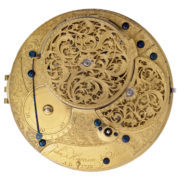 H4 – Harrison’s prize-winning longitude watch and progenitor of the modern chronometer, completed in 1759. Used with permission by the National Maritime Museum.
H4 – Harrison’s prize-winning longitude watch and progenitor of the modern chronometer, completed in 1759. Used with permission by the National Maritime Museum.This outcome was what the act of 1714 required, and the means of judging its success were clearly defined. And it was those terms which, throughout his creative life, Harrison was encouraged by the government’s commissioners to observe – the encouragement and observance clearly recorded in the minutes of the Board of Longitude, up until the 1750s. Harrison was thus justifiably annoyed when, during the 1750s and 60s, authorities began to “re-interpret” the terms of the original act. The assurances and agreements shown to Harrison by earlier commissioners were ignored. New rules required evidence that the timekeepers could be reproduced in large numbers and by other craftsmen, things which were never contemplated in the original act.
Had those stipulations been proposed for inclusion in the act of 1714, which they could easily have been had it been deemed appropriate, one can readily imagine those drafting the requirements rejecting the suggestion, on the basis that the act was designed primarily to determine if such a thing were possible at all – “let us not run before we can walk.” If a viable method were brought forward and shown to work under the terms of the act, then the £20,000 would have been well spent. Although this was a large sum to a person, in terms of the Navy budget it was not. It was less than half the cost of a second-rate ship of the line. Saving just one vessel from shipwreck would doubly repay the cost. In the very likely event that such a method would need further development, then further acts might regulate further rewards for the fine-tuning of such methods. And this is precisely what happened, despite the commissioners’ reluctance to co-operate. The board subsequently funded a select few in the next generation of watchmakers to further develop Harrison’s design into something less complex and expensive – much in the way one sees the development of most technological products in our own times.
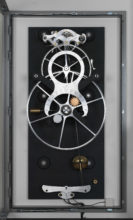 Clock B by Martin Burgess. Used with permission by the National Maritime Museum.
Clock B by Martin Burgess. Used with permission by the National Maritime Museum.There is another part of precision horology – that of high accuracy land-based timekeeping, and John Harrison had revolutionary views in this area too. In 1976, mechanical engineer Bill Laycock wrote The Lost Science of John Longitude Harrison. The book outlined Harrison’s very different philosophy in pendulum clock design. Laycock’s work inspired horological sculptor Martin Burgess to create a pair of Harrison-type precision pendulum clocks. Burgess hoped these might prove the efficacy of Harrison’s design, and reach Harrison’s predicted performance of keeping time to within one second in 100 days. This kind of performance was not only unheard of in the 18th century but also in the present day, where even the best pendulum clocks have not attained such performance. Harrison’s claim has thus always been doubted by most in the traditional horological world, but independent trials are now proving that Harrison’s principles were correct, and the performance of one second in 100 days has been readily achieved.
Featured Image Credit: Pixabay
The post How John Harrison invented the first portable precision timekeeper appeared first on OUPblog.

July 16, 2020
Six books to help us understand eating disorders
Some 70 million people worldwide have an eating disorder and, with the prevalence of disordered eating on the rise, it’s clear that this presents a significant public health issue. Despite this, many myths and misconceptions abound that are significant barriers to both treatment and public understanding of eating disorders. Anyone can develop an eating disorder, regardless of age, gender, or cultural background.
We’ve put together a list of books that provide practical information to dispel misconceptions, as well as guidance for people affected by eating disorders and their loved ones.
1. If Your Adolescent Has An Eating Disorder: An Essential Guide for Parents by B. Timothy Walsh and Deborah R. Glasofer 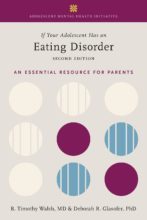
This is an authoritative guide to understanding and helping a teenager with an eating disorder. It is designed for parents of teens who have recently been diagnosed with an eating disorder, or who are at risk of developing one, and for other adults, such as teachers and guidance counselors, who are regularly in contact with at-risk adolescents. The book combines the latest science–including the newest treatments and most up-to-date research findings on eating disorders–with the practical wisdom of parents who have been raising teens with eating disorders.
2. Eating Disorders: What Everyone Needs to Know by B. Timothy Walsh, Evelyn Attia, and Deborah R. Glasofer
Practical yet authoritative, this book defines eating disorders, explains what we know about them based on the latest science, and describes how treatment works. The book dispels common myths about eating disorders, such as the notion that they occur only amongst the affluent, that they affect only girls and women, or that they simply result from environmental factors such as the fashion industry and society’s obsession with thinness. This book is essential reading for those seeking authoritative and current information about these often-misunderstood illnesses.
3. The Void Inside: Bringing Purging Disorder to Light by Pamela K. Keel
This book chronicles the growing recognition of purging disorder at the turn of the millennium, reviews what science has taught us about the illness, and explains the medical complications that purging may bring. The author, known for her work identifying and naming purging disorder, presents irrefutable evidence that it can no longer be considered a subset of better-known eating disorders. Keel illuminates how the illness impacts the lives of real people to underscore the severity of this hidden eating disorder and the need for greater awareness.
4. Exposure Therapy for Eating Disorders by Carolyn Black Becker, Nicholas R. Farrell, and Glenn Waller
This book is designed to augment existing eating disorder treatment manuals by providing clinicians with practical advice for maximizing the effectiveness of exposure, regardless of clinical background or evidence-based treatment used. Suitable for use with a range of diagnoses, this easy-to-use guide describes the most up to date empirical research on exposure for eating disorders. The book also provides strategies for overcoming obstacles, including institutional resistance to implementation of exposure therapy.
5. Handbook of Positive Body Image and Embodiment by Tracy L. Tylka and Niva Piran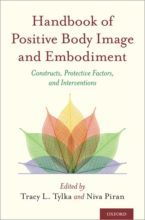
This book is the first comprehensive, research-based resource to address the breadth of innovative theoretical concepts and related practices concerning positive ways of living in the body. Presenting chapters by world-renowned experts in body image and eating behaviors, the handbook explores how therapeutic interventions and public health and policy initiatives can inform scholarly, clinical, and prevention-based work in the field of eating disorders.
6. Eating Disorders: The Facts by Suzanne Abraham
Sympathetically and clearly written, this guide considers why eating disorders occur, and then looks at each in turn, describing the eating behaviours, diagnosis, and treatments available. Case histories and patient perspectives provide insights into the mind of the eating disorder sufferer, making it easier for patients and their families to relate to the topics discussed. The book provides an authoritative resource on eating disorders that will prove valuable for sufferers and their families.
These titles highlight some of the most pressing issues in the field of eating disorder research. Greater awareness among stakeholders – including healthcare workers, researchers, policymakers, and the general public – can address ongoing challenges and inform future directions.
Featured Image Credit: Image by jannoon028 via Freepik
The post Six books to help us understand eating disorders appeared first on OUPblog.

Oxford University Press's Blog
- Oxford University Press's profile
- 238 followers



